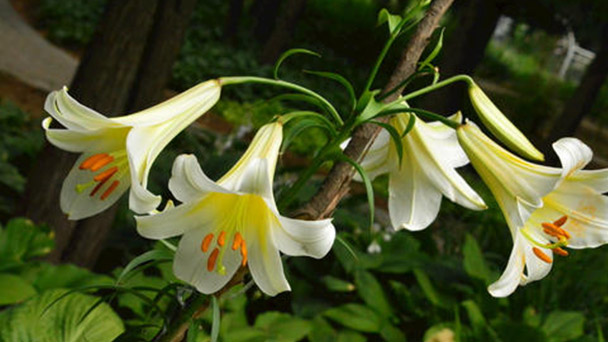Propagation methods of lily
Written by Maggie
Mar 17 2021

Lilies can be propagated by sowing, scaly cuttings, bulbous and bead buds. Flower friends can select the appropriate propagation methods according to their own conditions. The following four propagation methods of lilies are sorted out.

Sowing propagation method of lily
Lily sowing propagation, generally first in the autumn seeds, and the lily seeds will be collected storage to the next spring seeding. Generally in the spring, directly seeded seeds to the soil and then watering moisturizing. After the general seeding about 20-30 days of germination.
Wait until the lilies are young and need proper shade. Generally, when autumn comes, the underground part has formed small bulbs, which can be dug out and planted. Sowing needs 3 years to blossom, also some breeds need to cultivate old ability to open an account, do not propose the family to use sowing.
Scaly cutting propagation method of lily
In autumn, the bulb of lily can be dug out. Flower friends can break off the full and thick scales on the old scales, and the base of each scale needs to have a small part of the stem plate, and then put it in a cool place to dry. After drying, it can be directly cut into a flower pot or shallow wooden box containing good river sand.
Generally, in the process of insertion propagation of lily, 2/3 of the scales are inserted into the matrix, and the matrix should be maintained with a certain humidity. The general ambient temperature is about 20 degrees, and the scale wounds will root in about 1 and a half months.
Bulb propagation method of lily
1. Propagation time
If you want to propagate lily with lily bulbs, you must choose the right time to propagate. The bulb propagation of lily is usually done to divide an already dense lily into several plants. Bulb propagation is best chosen in the spring, which is conducive to plant growth and bud generation, and is carried out when the lily is out of the pot and ready to divide.

2. Cut the bulbs
Wash the roots of the lily plant and break off the small bulbs attached to the healthy bulbs. Many flower friends do not know how to propagate lily stems, in fact, as long as the time to pay attention to a point, there will be no wrong. If in doubt, use a sterilized knife and carefully cut from where they are attached.
3. Bulb disinfection
When a lily bulb is broken off, it leaves a wound on the bulb that cannot be planted immediately. It can cause bacterial infection in the root, which can make the plant sick and difficult to survive. Soak the bulbs in a diluted solution of potassium potato before planting. After a day and night, remove the bulbs and let them dry.
4. Choose basin soil
Lilies like loose soil, preferably with a little acidity in the soil. Mix peat with sand. Don't let the soil get sticky, which can stop the plants from germinating. As far as possible with a wide mouth shallow pot, it is best to use the pot mouth diameter is greater than the depth of the earthenware flowerpot breathable.
5. Plant bulbs
When the potted soil is ready and the lily bulbs have been treated, they can be planted directly. Dig the soil into a small pit and place the bulbs in the pit. Slowly cover the soil. But don't press it too deep. Then, water to drench the soil. Place the pot in a cool, airy place and wait for new shoots to appear.
Bud propagation method of lily
The small bulb that can form in the axillary place of the stem and leaf on lilly ground commonly, call again "bead bud", flower friend should take down its only culture. It usually takes two to four years for the main bud to blossom from large bulb to flower. To promote the production of small buds for propagation, after flowering, the stem on the ground was crushed and shallowly buried in the soil. The stem on the ground was divided into small segments with 3 to 4 leaves in each segment. When the stem nodes were shallowly buried in the wet sand, small pearl buds could grow in the axils of the leaves.

Latest Updated
- Benefits of Bugleweed - 7 Science-backed Health Benefits
- Bugleweed Dangers & Side Effects - Is It Poisonous?
- How to Plant Evergreen Trees - What You Should Know
- When to Plant Evergreens - Grow Guide for Evergreen Trees
- 12 Wonderful Evergreen Shrubs for Your Garden
- 12 Popular Evergreen Plants with Pictures for Beginners
- When And How To Prune A Lilac Bush Like a Pro
- How to Grow & Care for Lilac Vine (Hardenbergia Violacea)
- Japanese Lilac Tree (Syringa Reticulata) Care & Propagation Guide
- Shumard Oak Pros and Cons - What to Know
Popular Articles
- Winter maintenance of Antirrhinum Majus
- How to Grow Terminalia Mantaly Tree
- How to Grow and Care for Crossostephium Chinense
- How to grow Antirrhinum Majus in spring
- Peristeria Elata (Dove Orchid) Profile: Info & Care Guide
- Underwatered Snake Plant (Sansevieria Trifasciata) - Signs And How To Fix
- How to Care for Brazilian Jasmine Plant (Mandevilla Sanderi)
- How to Grow & Care for Graptopetalum Purple Delight in Summer
- Rosa Chinensis (China Rose): Plant Growing & Care Tips
- How to Care for Baby Sun Rose (Aptenia Cordifolia)